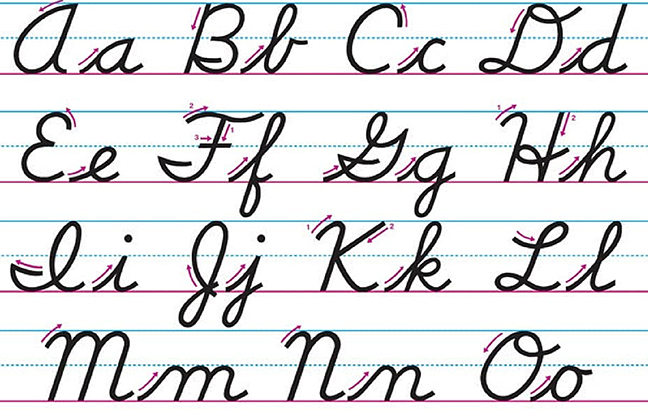Welcome!

Warren Dixon: Do we need cursive writing any more?
Willard says that before long, we won’t be able to see the handwriting on the wall.
You have to understand Willard, though. He’s all for keeping the old ways. If it were up to him, he’d still be listening to Brother Dave Gardner on his record player.
Willard was talking about cursive writing, which is quickly going the way of the turn table. Johnny can’t sign his name anymore. He prints it.
In 2013, North Carolina mandated that students should be able to write legible cursive by the fifth grade. Now, by sneaking in this “legible” requirement, North Carolina schools may have eliminated many of us from ever passing the fifth grade.
Then we have to realize that this is the computer age. Word processing programs have Spell Check, as does email. Nobody writes anymore, everyone texts, emails, photocopies or prints from their Hewlett Packard. And if they do write, they print.
Now, most students can print just as fast or faster than we can write in cursive. They just can’t sign their names.
Spell Check is a wonderful invention, but it’s not foolproof. Back when I turned columns in by sliding the typewritten version under the door of a local newspaper (late the night of the deadline, I might add), I came face to face with a typical Spell Check problem. Back then, we didn’t have Spell Check, of course, but we did have an enthusiastic newspaper employee who converted my typewritten column into newsprint.
Invariably, slight changes would be made to the column. A phrase like “hanging out” would be turned into “handing out.” “Possum” would be changed to “opossum,” a word that no true Southerner would ever, ever use. “Mortality” might become “morality” or “soaring” might end up as “soaking.” All of these were perfectly good words, just not the ones I wanted. The misspellings changed the meaning of sentences just enough to give me migraine headaches and leave my readers scratching their heads.
Somewhere in my filing cabinet are some wonderful letters, handwritten by Mom or an aunt, and perhaps a rare one from Dad. The penmanship in each one is a work of art in itself, perfectly spaced and flowing, each letter just the right height, a product of years of practice. The letters are so full of information (well, except for Dad’s), stuff you don’t get anymore in emails. As a matter of fact, all I ever get in emails anymore are emails forwarded from somewhere else. I certainly don’t get the comments on the weather, crops and neighbors like Aunt Ellen used to send or the great quips Henry King once mailed.
Sometimes cursive writing has caused problems in our house. I’ve mentioned the grocery lists Sandra has scribbled, causing me to bring back soap instead of soup. Then there have been the grocery lists that I wrote that, once cold, became illegible, causing me to bring back collard greens instead of Coca-Colas.
There’s a story of Horace Greeley, publisher of the New York Tribune, who was known for his horrible handwriting. He once wrote a note to a staff member, firing him for gross negligence of duty. Several years later, the journalist told his former boss how useful the note had been to his career. “I took it with me,” he said. “Nobody could read it, so I declared it a letter of recommendation, gave it my own interpretation, and obtained several first-class situations by it. I am really very much obliged to you.”
I’ve also mentioned in this space how I once left a note to a rural carrier, asking him to hold a customer’s mail. Except that my note was so quickly scribbled and barely readable that the carrier held the wrong customer’s mail for over a week.
Doctors’ sloppy handwriting used to kill around 7,000 people in the U.S. annually, through misinterpreted instructions on the 3.2 billion prescriptions written every year. Now prescriptions are printed, called in or emailed.
So why would anyone need to learn cursive nowadays? That is, other than signing their name to their weekly checks (which probably will be directly deposited anyway)? You can’t expect someone to learn something merely because we did it or because it’s an art form. At least it’s an art form the way it was once done, not the way I write a grocery list using it.
One drawback to not learning cursive is that by not learning to write it, you can’t read it. If you were going to study any historic documents or primary source documents (such as Aunt Ellen’s letters), you’d have to know cursive. If not, maybe cursive is no longer needed in our society. And there’s always Spell Check, so maybe spelling tests will become obsolete, too.
This anonymous poem, “Ode to the Spell Check”, says it best:
“Eye halve a spelling chequer,
It cam with my pea sea.
It plainly marques four my revue
Miss steaks eye kin knot sea.
Eye strike a key and type a word,
And weight four it two say
Weather eye am wrong oar write
It shows me strait a weigh.
Eye have run this poem threw it
I am shore your pleased two no
Its letter perfect awl the weigh
My chequer tolled me sew.
